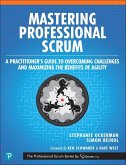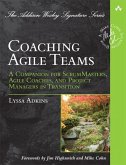Mike Cohn
Agile Estimating and Planning
Mike Cohn
Agile Estimating and Planning
- Broschiertes Buch
- Merkliste
- Auf die Merkliste
- Bewerten Bewerten
- Teilen
- Produkt teilen
- Produkterinnerung
- Produkterinnerung
The first step to project success is accurate estimating and realistic planning.
Projects with unrealistic expectations affixed to them are likely to derail at an
early stage. This book shows the software practitioner how to effectively
estimate and properly plan a project within an agile context. The book's
content is suitable for projects using any agile or semi-agile process (such as
Extreme Programming, Scrum, Feature Driven Development, Crystal,
Adaptive Software Development, DSDM or even the IBM Rational Unified
Process). The ideas in this book will work with any…mehr
Andere Kunden interessierten sich auch für
![Specification by Example Specification by Example]() Gojko AdzicSpecification by Example46,99 €
Gojko AdzicSpecification by Example46,99 €![Succeeding with Agile Succeeding with Agile]() Mike CohnSucceeding with Agile34,99 €
Mike CohnSucceeding with Agile34,99 €![Agile Product Management with Scrum Agile Product Management with Scrum]() Roman PichlerAgile Product Management with Scrum24,99 €
Roman PichlerAgile Product Management with Scrum24,99 €![Mastering Professional Scrum Mastering Professional Scrum]() Stephanie OckermanMastering Professional Scrum23,99 €
Stephanie OckermanMastering Professional Scrum23,99 €![Coaching Agile Teams Coaching Agile Teams]() Lyssa AdkinsCoaching Agile Teams34,99 €
Lyssa AdkinsCoaching Agile Teams34,99 €![Agile Project Management with Kanban Agile Project Management with Kanban]() Eric BrechnerAgile Project Management with Kanban23,99 €
Eric BrechnerAgile Project Management with Kanban23,99 €![The Professional Product Owner The Professional Product Owner]() Don McGrealThe Professional Product Owner23,99 €
Don McGrealThe Professional Product Owner23,99 €-
-
-
-
-
-
The first step to project success is accurate estimating and realistic planning.
Projects with unrealistic expectations affixed to them are likely to derail at an
early stage. This book shows the software practitioner how to effectively
estimate and properly plan a project within an agile context. The book's
content is suitable for projects using any agile or semi-agile process (such as
Extreme Programming, Scrum, Feature Driven Development, Crystal,
Adaptive Software Development, DSDM or even the IBM Rational Unified
Process). The ideas in this book will work with any iterative development
process, which greatly broadens the target audience beyond the traditional agile
community. Each chapter is supported by a summary and a set of questions
that allows readers to assess their ability to estimate and plan a project. The
result is an engaging read with pearls of wisdom that can be applied to the
reader's next project.
Projects with unrealistic expectations affixed to them are likely to derail at an
early stage. This book shows the software practitioner how to effectively
estimate and properly plan a project within an agile context. The book's
content is suitable for projects using any agile or semi-agile process (such as
Extreme Programming, Scrum, Feature Driven Development, Crystal,
Adaptive Software Development, DSDM or even the IBM Rational Unified
Process). The ideas in this book will work with any iterative development
process, which greatly broadens the target audience beyond the traditional agile
community. Each chapter is supported by a summary and a set of questions
that allows readers to assess their ability to estimate and plan a project. The
result is an engaging read with pearls of wisdom that can be applied to the
reader's next project.
Produktdetails
- Produktdetails
- Robert C. Martin Series
- Verlag: Pearson Education
- Seitenzahl: 368
- Erscheinungstermin: 1. November 2005
- Englisch
- Abmessung: 235mm x 178mm x 20mm
- Gewicht: 604g
- ISBN-13: 9780131479418
- ISBN-10: 0131479415
- Artikelnr.: 14031743
- Herstellerkennzeichnung
- Prentice Hall
- St.-Martin-Straße 82
- 81541 München
- salesde@pearson.com
- Robert C. Martin Series
- Verlag: Pearson Education
- Seitenzahl: 368
- Erscheinungstermin: 1. November 2005
- Englisch
- Abmessung: 235mm x 178mm x 20mm
- Gewicht: 604g
- ISBN-13: 9780131479418
- ISBN-10: 0131479415
- Artikelnr.: 14031743
- Herstellerkennzeichnung
- Prentice Hall
- St.-Martin-Straße 82
- 81541 München
- salesde@pearson.com
Mike Cohn is the founder of Mountain Goat Software, a process and project management consultancy and training firm. With more than twenty years of experience, Mike has been a technology executive in companies ranging from start-ups to Fortune 40s, and is a founding member of the Agile Alliance. He frequently contributes to industry-related magazines and presents regularly at conferences. He is the author of User Stories Applied (Addison-Wesley, 2004).
About the Author xvii
Foreword by Robert C. Martin xix
Foreword by Jim Highsmith xxi
Foreword by Gabrielle Benefield xxv
Acknowledgments xxvii
Introduction xxix
Part I: The Problem and the Goal 1Chapter 1: The Purpose of Planning 3
Why Do It? 5
What Makes a Good Plan? 8
What Makes Planning Agile? 9
Summary 10
Discussion Questions 10
Chapter 2: Why Planning Fails 11
Planning Is by Activity Rather Than Feature 12
Multitasking Causes Further Delays 15
Features Are Not Developed by Priority 17
We Ignore Uncertainty 17
Estimates Become Commitments 18
Summary 18
Discussion Questions 19
Chapter 3: An Agile Approach 21
An Agile Approach to Projects 23
An Agile Approach to Planning 27
Summary 31
Discussion Questions 32
Part II: Estimating Size 33Chapter 4: Estimating Size with Story Points 35
Story Points Are Relative 36
Velocity 38
Summary 40
Discussion Questions 41
Chapter 5: Estimating in Ideal Days 43
Ideal Time and Software Development 44
Ideal Days as a Measure of Size 46
One Estimate, Not Many 46
Summary 47
Discussion Questions 47
Chapter 6: Techniques for Estimating 49
Estimates Are Shared 51
The Estimation Scale 52
Deriving an Estimate 54
Planning Poker 56
Why Planning Poker Works 59
Summary 60
Discussion Questions 60
Chapter 7: Re-Estimating 61
Introducing the SwimStats Website 61
When Not to Re-Estimate 62
When to Re-Estimate 64
Re-Estimating Partially Completed Stories 66
The Purpose of Re-Estimating 67
Summary 67
Discussion Questions 67
Chapter 8: Choosing between Story Points and Ideal Days 69
Considerations Favoring Story Points 69
Considerations Favoring Ideal Days 72
Recommendation 73
Summary 74
Discussion Questions 75
Part III: Planning for Value 77Chapter 9: Prioritizing Themes 79
Factors in Prioritization 80
Combining the Four Factors 86
Some Examples 86
Summary 88
Discussion Questions 89
Chapter 10: Financial Prioritization 91
Sources of Return 93
An Example: WebPayroll 96
Financial Measures 102
Comparing Returns 108
Summary 109
Discussion Questions 109
Chapter 11: Prioritizing Desirability 111
Kano Model of Customer Satisfaction 112
Relative Weighting: Another Approach 117
Summary 119
Discussion Questions 120
Chapter 12: Splitting User Stories 121
When to Split a User Story 121
Splitting across Data Boundaries 122
Splitting on Operational Boundaries 124
Removing Cross-Cutting Concerns 125
Don't Meet Performance Constraints 126
Split Stories of Mixed Priority 127
Don't Split a Story into Tasks 127
Avoid the Temptation of Related Changes 128
Combining Stories 128
Summary 129
Discussion Questions 129
Part IV: Scheduling 131 Chapter 13: Release Planning Essentials 133
The Release Plan 134
Updating the Release Plan 138
An Example 139
Summary 142
Discussion Questions 143
Chapter 14: Iteration Planning 145
Tasks Are Not Allocated During Iteration Planning 147
How Iteration and Release Planning Differ 148
Velocity-Driven Iteration Planning 149
Commitment-Driven Iteration Planning 158
My Recommendation 162
Relating Task Estimates to Story Points 163
Summary 165
Discussion Questions 166
Chapter 15: Selecting an Iteration Length 167
Factors in Selecting an Iteration Length 167
Making a Decision 171
Two Case Studies 173
Summary 175
Discussion Questions 176
Chapter 16: Estimating Velocity 177
Use Historical Values 178
Run an Iteration 179
Make a Forecast 181
Which Approach Should I Use? 185
Summary 186
Discussion Questions 186
Chapter 17: Buffering Plans for Uncertainty 187
Feature Buffers 188
Schedule Buffers 189
Combining Buffers 198
A Schedule Buffer Is Not Padding 199
Some Caveats 199
Summary 200
Discussion Questions 201
Chapter 18: Planning the Multiple-Team Project 203
Establishing a Common Basis for Estimates 204
Adding Detail to User Stories Sooner 205
Lookahead Planning 206
Incorporating Feeding Buffers into the Plan 208
But This Is So Much Work 210
Summary 210
Discussion Questions 211
Part V: Tracking and Communicating 213 Chapter 19: Monitoring the Release
Plan 215
Tracking the Release 216
Release Burndown Charts 219
A Parking-Lot Chart 224
Summary 225
Discussion Questions 226
Chapter 20: Monitoring the Iteration Plan 227
The Task Board 227
Iteration Burndown Charts 230
Tracking Effort Expended 231
Individual Velocity 232
Summary 232
Discussion Questions 233
Chapter 21: Communicating about Plans 235
Communicating the Plan 237
Communicating Progress 238
An End-of-Iteration Summary 241
Summary 244
Discussion Questions 245
Part VI: Why Agile Planning Works 247 Chapter 22: Why Agile Planning Works
249
Replanning Occurs Frequently 249
Estimates of Size and Duration Are Separated 250
Plans Are Made at Different Levels 251
Plans Are Based on Features, Not Tasks 252
Small Stories Keep Work Flowing 252
Work in Process Is Eliminated Every Iteration 252
Tracking Is at the Team Level 253
Uncertainty Is Acknowledged and Planned For 253
A Dozen Guidelines for Agile Estimating and Planning 254
Summary 256
Discussion Questions 257
Part VII: A Case Study 259Chapter 23: A Case Study: Bomb Shelter Studios
261
Day 1—Monday Morning 262
Estimating the User Stories 270
Preparing for Product Research 281
Iteration and Release Planning, Round 1 284
Two Weeks Later 302
Planning the Second Iteration 303
Two Weeks Later 305
Revising the Release Plan 305
Presenting the Revised Plan to Phil 308
Eighteen Weeks Later 312
Reference List 313
Index 319
Foreword by Robert C. Martin xix
Foreword by Jim Highsmith xxi
Foreword by Gabrielle Benefield xxv
Acknowledgments xxvii
Introduction xxix
Part I: The Problem and the Goal 1Chapter 1: The Purpose of Planning 3
Why Do It? 5
What Makes a Good Plan? 8
What Makes Planning Agile? 9
Summary 10
Discussion Questions 10
Chapter 2: Why Planning Fails 11
Planning Is by Activity Rather Than Feature 12
Multitasking Causes Further Delays 15
Features Are Not Developed by Priority 17
We Ignore Uncertainty 17
Estimates Become Commitments 18
Summary 18
Discussion Questions 19
Chapter 3: An Agile Approach 21
An Agile Approach to Projects 23
An Agile Approach to Planning 27
Summary 31
Discussion Questions 32
Part II: Estimating Size 33Chapter 4: Estimating Size with Story Points 35
Story Points Are Relative 36
Velocity 38
Summary 40
Discussion Questions 41
Chapter 5: Estimating in Ideal Days 43
Ideal Time and Software Development 44
Ideal Days as a Measure of Size 46
One Estimate, Not Many 46
Summary 47
Discussion Questions 47
Chapter 6: Techniques for Estimating 49
Estimates Are Shared 51
The Estimation Scale 52
Deriving an Estimate 54
Planning Poker 56
Why Planning Poker Works 59
Summary 60
Discussion Questions 60
Chapter 7: Re-Estimating 61
Introducing the SwimStats Website 61
When Not to Re-Estimate 62
When to Re-Estimate 64
Re-Estimating Partially Completed Stories 66
The Purpose of Re-Estimating 67
Summary 67
Discussion Questions 67
Chapter 8: Choosing between Story Points and Ideal Days 69
Considerations Favoring Story Points 69
Considerations Favoring Ideal Days 72
Recommendation 73
Summary 74
Discussion Questions 75
Part III: Planning for Value 77Chapter 9: Prioritizing Themes 79
Factors in Prioritization 80
Combining the Four Factors 86
Some Examples 86
Summary 88
Discussion Questions 89
Chapter 10: Financial Prioritization 91
Sources of Return 93
An Example: WebPayroll 96
Financial Measures 102
Comparing Returns 108
Summary 109
Discussion Questions 109
Chapter 11: Prioritizing Desirability 111
Kano Model of Customer Satisfaction 112
Relative Weighting: Another Approach 117
Summary 119
Discussion Questions 120
Chapter 12: Splitting User Stories 121
When to Split a User Story 121
Splitting across Data Boundaries 122
Splitting on Operational Boundaries 124
Removing Cross-Cutting Concerns 125
Don't Meet Performance Constraints 126
Split Stories of Mixed Priority 127
Don't Split a Story into Tasks 127
Avoid the Temptation of Related Changes 128
Combining Stories 128
Summary 129
Discussion Questions 129
Part IV: Scheduling 131 Chapter 13: Release Planning Essentials 133
The Release Plan 134
Updating the Release Plan 138
An Example 139
Summary 142
Discussion Questions 143
Chapter 14: Iteration Planning 145
Tasks Are Not Allocated During Iteration Planning 147
How Iteration and Release Planning Differ 148
Velocity-Driven Iteration Planning 149
Commitment-Driven Iteration Planning 158
My Recommendation 162
Relating Task Estimates to Story Points 163
Summary 165
Discussion Questions 166
Chapter 15: Selecting an Iteration Length 167
Factors in Selecting an Iteration Length 167
Making a Decision 171
Two Case Studies 173
Summary 175
Discussion Questions 176
Chapter 16: Estimating Velocity 177
Use Historical Values 178
Run an Iteration 179
Make a Forecast 181
Which Approach Should I Use? 185
Summary 186
Discussion Questions 186
Chapter 17: Buffering Plans for Uncertainty 187
Feature Buffers 188
Schedule Buffers 189
Combining Buffers 198
A Schedule Buffer Is Not Padding 199
Some Caveats 199
Summary 200
Discussion Questions 201
Chapter 18: Planning the Multiple-Team Project 203
Establishing a Common Basis for Estimates 204
Adding Detail to User Stories Sooner 205
Lookahead Planning 206
Incorporating Feeding Buffers into the Plan 208
But This Is So Much Work 210
Summary 210
Discussion Questions 211
Part V: Tracking and Communicating 213 Chapter 19: Monitoring the Release
Plan 215
Tracking the Release 216
Release Burndown Charts 219
A Parking-Lot Chart 224
Summary 225
Discussion Questions 226
Chapter 20: Monitoring the Iteration Plan 227
The Task Board 227
Iteration Burndown Charts 230
Tracking Effort Expended 231
Individual Velocity 232
Summary 232
Discussion Questions 233
Chapter 21: Communicating about Plans 235
Communicating the Plan 237
Communicating Progress 238
An End-of-Iteration Summary 241
Summary 244
Discussion Questions 245
Part VI: Why Agile Planning Works 247 Chapter 22: Why Agile Planning Works
249
Replanning Occurs Frequently 249
Estimates of Size and Duration Are Separated 250
Plans Are Made at Different Levels 251
Plans Are Based on Features, Not Tasks 252
Small Stories Keep Work Flowing 252
Work in Process Is Eliminated Every Iteration 252
Tracking Is at the Team Level 253
Uncertainty Is Acknowledged and Planned For 253
A Dozen Guidelines for Agile Estimating and Planning 254
Summary 256
Discussion Questions 257
Part VII: A Case Study 259Chapter 23: A Case Study: Bomb Shelter Studios
261
Day 1—Monday Morning 262
Estimating the User Stories 270
Preparing for Product Research 281
Iteration and Release Planning, Round 1 284
Two Weeks Later 302
Planning the Second Iteration 303
Two Weeks Later 305
Revising the Release Plan 305
Presenting the Revised Plan to Phil 308
Eighteen Weeks Later 312
Reference List 313
Index 319
About the Author xvii
Foreword by Robert C. Martin xix
Foreword by Jim Highsmith xxi
Foreword by Gabrielle Benefield xxv
Acknowledgments xxvii
Introduction xxix
Part I: The Problem and the Goal 1Chapter 1: The Purpose of Planning 3
Why Do It? 5
What Makes a Good Plan? 8
What Makes Planning Agile? 9
Summary 10
Discussion Questions 10
Chapter 2: Why Planning Fails 11
Planning Is by Activity Rather Than Feature 12
Multitasking Causes Further Delays 15
Features Are Not Developed by Priority 17
We Ignore Uncertainty 17
Estimates Become Commitments 18
Summary 18
Discussion Questions 19
Chapter 3: An Agile Approach 21
An Agile Approach to Projects 23
An Agile Approach to Planning 27
Summary 31
Discussion Questions 32
Part II: Estimating Size 33Chapter 4: Estimating Size with Story Points 35
Story Points Are Relative 36
Velocity 38
Summary 40
Discussion Questions 41
Chapter 5: Estimating in Ideal Days 43
Ideal Time and Software Development 44
Ideal Days as a Measure of Size 46
One Estimate, Not Many 46
Summary 47
Discussion Questions 47
Chapter 6: Techniques for Estimating 49
Estimates Are Shared 51
The Estimation Scale 52
Deriving an Estimate 54
Planning Poker 56
Why Planning Poker Works 59
Summary 60
Discussion Questions 60
Chapter 7: Re-Estimating 61
Introducing the SwimStats Website 61
When Not to Re-Estimate 62
When to Re-Estimate 64
Re-Estimating Partially Completed Stories 66
The Purpose of Re-Estimating 67
Summary 67
Discussion Questions 67
Chapter 8: Choosing between Story Points and Ideal Days 69
Considerations Favoring Story Points 69
Considerations Favoring Ideal Days 72
Recommendation 73
Summary 74
Discussion Questions 75
Part III: Planning for Value 77Chapter 9: Prioritizing Themes 79
Factors in Prioritization 80
Combining the Four Factors 86
Some Examples 86
Summary 88
Discussion Questions 89
Chapter 10: Financial Prioritization 91
Sources of Return 93
An Example: WebPayroll 96
Financial Measures 102
Comparing Returns 108
Summary 109
Discussion Questions 109
Chapter 11: Prioritizing Desirability 111
Kano Model of Customer Satisfaction 112
Relative Weighting: Another Approach 117
Summary 119
Discussion Questions 120
Chapter 12: Splitting User Stories 121
When to Split a User Story 121
Splitting across Data Boundaries 122
Splitting on Operational Boundaries 124
Removing Cross-Cutting Concerns 125
Don't Meet Performance Constraints 126
Split Stories of Mixed Priority 127
Don't Split a Story into Tasks 127
Avoid the Temptation of Related Changes 128
Combining Stories 128
Summary 129
Discussion Questions 129
Part IV: Scheduling 131 Chapter 13: Release Planning Essentials 133
The Release Plan 134
Updating the Release Plan 138
An Example 139
Summary 142
Discussion Questions 143
Chapter 14: Iteration Planning 145
Tasks Are Not Allocated During Iteration Planning 147
How Iteration and Release Planning Differ 148
Velocity-Driven Iteration Planning 149
Commitment-Driven Iteration Planning 158
My Recommendation 162
Relating Task Estimates to Story Points 163
Summary 165
Discussion Questions 166
Chapter 15: Selecting an Iteration Length 167
Factors in Selecting an Iteration Length 167
Making a Decision 171
Two Case Studies 173
Summary 175
Discussion Questions 176
Chapter 16: Estimating Velocity 177
Use Historical Values 178
Run an Iteration 179
Make a Forecast 181
Which Approach Should I Use? 185
Summary 186
Discussion Questions 186
Chapter 17: Buffering Plans for Uncertainty 187
Feature Buffers 188
Schedule Buffers 189
Combining Buffers 198
A Schedule Buffer Is Not Padding 199
Some Caveats 199
Summary 200
Discussion Questions 201
Chapter 18: Planning the Multiple-Team Project 203
Establishing a Common Basis for Estimates 204
Adding Detail to User Stories Sooner 205
Lookahead Planning 206
Incorporating Feeding Buffers into the Plan 208
But This Is So Much Work 210
Summary 210
Discussion Questions 211
Part V: Tracking and Communicating 213 Chapter 19: Monitoring the Release
Plan 215
Tracking the Release 216
Release Burndown Charts 219
A Parking-Lot Chart 224
Summary 225
Discussion Questions 226
Chapter 20: Monitoring the Iteration Plan 227
The Task Board 227
Iteration Burndown Charts 230
Tracking Effort Expended 231
Individual Velocity 232
Summary 232
Discussion Questions 233
Chapter 21: Communicating about Plans 235
Communicating the Plan 237
Communicating Progress 238
An End-of-Iteration Summary 241
Summary 244
Discussion Questions 245
Part VI: Why Agile Planning Works 247 Chapter 22: Why Agile Planning Works
249
Replanning Occurs Frequently 249
Estimates of Size and Duration Are Separated 250
Plans Are Made at Different Levels 251
Plans Are Based on Features, Not Tasks 252
Small Stories Keep Work Flowing 252
Work in Process Is Eliminated Every Iteration 252
Tracking Is at the Team Level 253
Uncertainty Is Acknowledged and Planned For 253
A Dozen Guidelines for Agile Estimating and Planning 254
Summary 256
Discussion Questions 257
Part VII: A Case Study 259Chapter 23: A Case Study: Bomb Shelter Studios
261
Day 1—Monday Morning 262
Estimating the User Stories 270
Preparing for Product Research 281
Iteration and Release Planning, Round 1 284
Two Weeks Later 302
Planning the Second Iteration 303
Two Weeks Later 305
Revising the Release Plan 305
Presenting the Revised Plan to Phil 308
Eighteen Weeks Later 312
Reference List 313
Index 319
Foreword by Robert C. Martin xix
Foreword by Jim Highsmith xxi
Foreword by Gabrielle Benefield xxv
Acknowledgments xxvii
Introduction xxix
Part I: The Problem and the Goal 1Chapter 1: The Purpose of Planning 3
Why Do It? 5
What Makes a Good Plan? 8
What Makes Planning Agile? 9
Summary 10
Discussion Questions 10
Chapter 2: Why Planning Fails 11
Planning Is by Activity Rather Than Feature 12
Multitasking Causes Further Delays 15
Features Are Not Developed by Priority 17
We Ignore Uncertainty 17
Estimates Become Commitments 18
Summary 18
Discussion Questions 19
Chapter 3: An Agile Approach 21
An Agile Approach to Projects 23
An Agile Approach to Planning 27
Summary 31
Discussion Questions 32
Part II: Estimating Size 33Chapter 4: Estimating Size with Story Points 35
Story Points Are Relative 36
Velocity 38
Summary 40
Discussion Questions 41
Chapter 5: Estimating in Ideal Days 43
Ideal Time and Software Development 44
Ideal Days as a Measure of Size 46
One Estimate, Not Many 46
Summary 47
Discussion Questions 47
Chapter 6: Techniques for Estimating 49
Estimates Are Shared 51
The Estimation Scale 52
Deriving an Estimate 54
Planning Poker 56
Why Planning Poker Works 59
Summary 60
Discussion Questions 60
Chapter 7: Re-Estimating 61
Introducing the SwimStats Website 61
When Not to Re-Estimate 62
When to Re-Estimate 64
Re-Estimating Partially Completed Stories 66
The Purpose of Re-Estimating 67
Summary 67
Discussion Questions 67
Chapter 8: Choosing between Story Points and Ideal Days 69
Considerations Favoring Story Points 69
Considerations Favoring Ideal Days 72
Recommendation 73
Summary 74
Discussion Questions 75
Part III: Planning for Value 77Chapter 9: Prioritizing Themes 79
Factors in Prioritization 80
Combining the Four Factors 86
Some Examples 86
Summary 88
Discussion Questions 89
Chapter 10: Financial Prioritization 91
Sources of Return 93
An Example: WebPayroll 96
Financial Measures 102
Comparing Returns 108
Summary 109
Discussion Questions 109
Chapter 11: Prioritizing Desirability 111
Kano Model of Customer Satisfaction 112
Relative Weighting: Another Approach 117
Summary 119
Discussion Questions 120
Chapter 12: Splitting User Stories 121
When to Split a User Story 121
Splitting across Data Boundaries 122
Splitting on Operational Boundaries 124
Removing Cross-Cutting Concerns 125
Don't Meet Performance Constraints 126
Split Stories of Mixed Priority 127
Don't Split a Story into Tasks 127
Avoid the Temptation of Related Changes 128
Combining Stories 128
Summary 129
Discussion Questions 129
Part IV: Scheduling 131 Chapter 13: Release Planning Essentials 133
The Release Plan 134
Updating the Release Plan 138
An Example 139
Summary 142
Discussion Questions 143
Chapter 14: Iteration Planning 145
Tasks Are Not Allocated During Iteration Planning 147
How Iteration and Release Planning Differ 148
Velocity-Driven Iteration Planning 149
Commitment-Driven Iteration Planning 158
My Recommendation 162
Relating Task Estimates to Story Points 163
Summary 165
Discussion Questions 166
Chapter 15: Selecting an Iteration Length 167
Factors in Selecting an Iteration Length 167
Making a Decision 171
Two Case Studies 173
Summary 175
Discussion Questions 176
Chapter 16: Estimating Velocity 177
Use Historical Values 178
Run an Iteration 179
Make a Forecast 181
Which Approach Should I Use? 185
Summary 186
Discussion Questions 186
Chapter 17: Buffering Plans for Uncertainty 187
Feature Buffers 188
Schedule Buffers 189
Combining Buffers 198
A Schedule Buffer Is Not Padding 199
Some Caveats 199
Summary 200
Discussion Questions 201
Chapter 18: Planning the Multiple-Team Project 203
Establishing a Common Basis for Estimates 204
Adding Detail to User Stories Sooner 205
Lookahead Planning 206
Incorporating Feeding Buffers into the Plan 208
But This Is So Much Work 210
Summary 210
Discussion Questions 211
Part V: Tracking and Communicating 213 Chapter 19: Monitoring the Release
Plan 215
Tracking the Release 216
Release Burndown Charts 219
A Parking-Lot Chart 224
Summary 225
Discussion Questions 226
Chapter 20: Monitoring the Iteration Plan 227
The Task Board 227
Iteration Burndown Charts 230
Tracking Effort Expended 231
Individual Velocity 232
Summary 232
Discussion Questions 233
Chapter 21: Communicating about Plans 235
Communicating the Plan 237
Communicating Progress 238
An End-of-Iteration Summary 241
Summary 244
Discussion Questions 245
Part VI: Why Agile Planning Works 247 Chapter 22: Why Agile Planning Works
249
Replanning Occurs Frequently 249
Estimates of Size and Duration Are Separated 250
Plans Are Made at Different Levels 251
Plans Are Based on Features, Not Tasks 252
Small Stories Keep Work Flowing 252
Work in Process Is Eliminated Every Iteration 252
Tracking Is at the Team Level 253
Uncertainty Is Acknowledged and Planned For 253
A Dozen Guidelines for Agile Estimating and Planning 254
Summary 256
Discussion Questions 257
Part VII: A Case Study 259Chapter 23: A Case Study: Bomb Shelter Studios
261
Day 1—Monday Morning 262
Estimating the User Stories 270
Preparing for Product Research 281
Iteration and Release Planning, Round 1 284
Two Weeks Later 302
Planning the Second Iteration 303
Two Weeks Later 305
Revising the Release Plan 305
Presenting the Revised Plan to Phil 308
Eighteen Weeks Later 312
Reference List 313
Index 319








